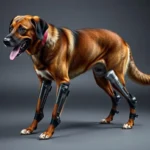
Introduction
Canine Degenerative Myelopathy (CDM) is a progressive neurological disorder that affects the spinal cord of dogs, leading to a gradual loss of mobility. This condition is particularly concerning for dog owners, as it often manifests in older dogs and can significantly impact their quality of life. Understanding CDM is crucial for any dog owner, as early detection and management can make a substantial difference in the dog’s well-being.
The broader context of dog health care encompasses a range of issues beyond just CDM. As responsible pet owners, it is vital to stay informed about potential health problems, ensuring our furry companions lead healthy and fulfilling lives. Early detection of health issues, including CDM, enables better management strategies and enhances the overall quality of life for dogs.
Understanding Canine Degenerative Myelopathy
What is Degenerative Myelopathy?
Degenerative Myelopathy is a disease characterized by the progressive degeneration of the spinal cord, particularly affecting the hind limbs. It is caused by the degeneration of nerve fibers, which results in impaired communication between the brain and the body. Unlike other neurological disorders, such as intervertebral disc disease or canine distemper, CDM does not cause pain and primarily affects mobility.
The mechanism of CDM involves the loss of myelin, the protective sheath around nerve fibers, leading to disrupted signals. This process is gradual, and symptoms may take months or even years to manifest fully. Understanding this disease’s mechanism is essential for recognizing its implications on a dog’s health and mobility.
Causes and Risk Factors
Several factors contribute to the onset of canine degenerative myelopathy:
- Genetic Predisposition: Certain breeds are more susceptible to CDM, including:
- German Shepherds
- Boxers
- Pembroke Welsh Corgis
-
Labrador Retrievers
-
Environmental Factors: Although genetics play a significant role, environmental influences such as obesity and lack of exercise can exacerbate symptoms or accelerate progression.
-
Age: CDM typically affects older dogs, with most cases diagnosed in dogs aged 8 years and older.
Symptoms and Early Signs
The initial symptoms of canine degenerative myelopathy often include subtle changes in mobility, particularly in the hind limbs. Early signs may include:
- Difficulty getting up from a lying position
- Weakness in the hind legs
- Wobbling or unsteady gait
- Dragging of the back paws
As the disease progresses, additional symptoms may emerge, such as:
- Complete loss of coordination
- Inability to walk
- Muscle atrophy in the hindquarters
Being vigilant about these symptoms can lead to prompt veterinary consultations, which are crucial for effective management.
Diagnosis of Canine Degenerative Myelopathy
Veterinary Diagnosis Procedures
If you suspect your dog may be affected by canine degenerative myelopathy, consulting a veterinarian is the first step. A thorough veterinary examination is essential for accurate diagnosis and may include:
-
Neurological Examination: This involves assessing your dog’s reflexes, coordination, and overall neurological function.
-
Genetic Testing: A specific test can determine if your dog carries the SOD1 mutation associated with CDM.
Differential Diagnosis
It is essential to differentiate CDM from other conditions that may mimic its symptoms. Common conditions to rule out include:
- Intervertebral disc disease
- Spinal tumors
- Lyme disease
- Arthritis
Ruling out these diseases helps ensure that your dog receives the appropriate care and management for their specific condition.
Treatment Options for Canine Degenerative Myelopathy
Current Treatment Approaches
Currently, there is no cure for canine degenerative myelopathy, but several treatment options can help manage symptoms and improve quality of life. These include:
-
Physical Therapy: Regular physical therapy can help maintain muscle strength and mobility. Techniques such as hydrotherapy and range-of-motion exercises are beneficial.
-
Medications: While no specific medications can halt disease progression, anti-inflammatory drugs can alleviate discomfort and improve mobility.
-
Supportive Care: Providing a supportive environment is crucial. This may include mobility aids like harnesses or carts to assist with walking.
Experimental Treatments and Research
Research into potential treatments for canine degenerative myelopathy is ongoing. Some promising areas include:
-
Stem Cell Therapy: Early studies suggest that stem cell therapy may help regenerate nerve tissues, potentially slowing disease progression.
-
Gene Therapy: Researchers are exploring gene therapy to address the underlying genetic issues causing CDM, offering hope for future treatment.
As research continues to advance, new therapies may emerge, providing more options for affected dogs.
Managing a Dog with Canine Degenerative Myelopathy
Home Care Strategies
Creating a supportive home environment is essential for dogs with CDM. Here are some strategies to consider:
-
Mobility Aids: Invest in mobility aids such as harnesses or carts to help your dog move around with greater ease.
-
Safe Spaces: Remove obstacles around the home to prevent falls and ensure your dog has a safe environment.
-
Regular Exercise: While it may be challenging, maintaining a routine of low-impact exercises can help keep your dog active and engaged.
Nutritional Considerations
Diet plays a crucial role in the overall health of dogs with canine degenerative myelopathy. Here are some recommendations:
-
Balanced Diet: Ensure your dog’s diet is well-balanced, focusing on high-quality protein, healthy fats, and essential vitamins and minerals.
-
Supplements: Some supplements, such as omega-3 fatty acids and antioxidants, may support neurological health. Consult your veterinarian for specific recommendations.
Maintaining a proper diet can help manage weight and improve your dog’s overall health, which is particularly important for dogs with mobility issues.
Emotional and Psychological Support
The emotional impact of CDM can affect both the dog and the owner. It’s important to recognize the following:
-
Emotional Well-Being: Dogs may experience frustration or anxiety due to their declining mobility. Providing mental stimulation through interactive toys or games can help alleviate boredom.
-
Owner Support: As a dog owner, it’s essential to seek support for yourself. Consider joining support groups or online forums where you can share experiences and receive advice from others facing similar challenges.
Prevention of Canine Degenerative Myelopathy
Genetic Screening and Breeding Practices
Preventing canine degenerative myelopathy starts with responsible breeding practices. Here are some considerations:
-
Genetic Screening: Potential dog owners should consider genetic testing for the SOD1 mutation before acquiring a puppy. This information can guide decisions about breeding practices.
-
Responsible Breeding: Breeders who prioritize health testing can help reduce the prevalence of CDM in future generations.
Promoting Overall Canine Health
Maintaining optimal health in dogs can help mitigate the risk of various health issues, including CDM. Here are some tips:
-
Regular Veterinary Check-ups: Routine vet visits can help identify health issues early, allowing for timely interventions.
-
Balanced Diet and Exercise: A healthy diet and regular exercise are crucial for overall health, which can positively impact a dog’s mobility.
-
Early Intervention: Being proactive about any health changes can lead to better outcomes for your dog.
Conclusion
Understanding canine degenerative myelopathy is vital for dog owners, as it allows for prompt recognition and management of this challenging condition. By staying informed about the symptoms, treatment options, and supportive care, you can significantly improve your dog’s quality of life.
As a dog owner, it is essential to be proactive about your dog’s health care. Knowledge is power, and by remaining vigilant and informed, you can help your furry friend navigate the challenges associated with CDM.









